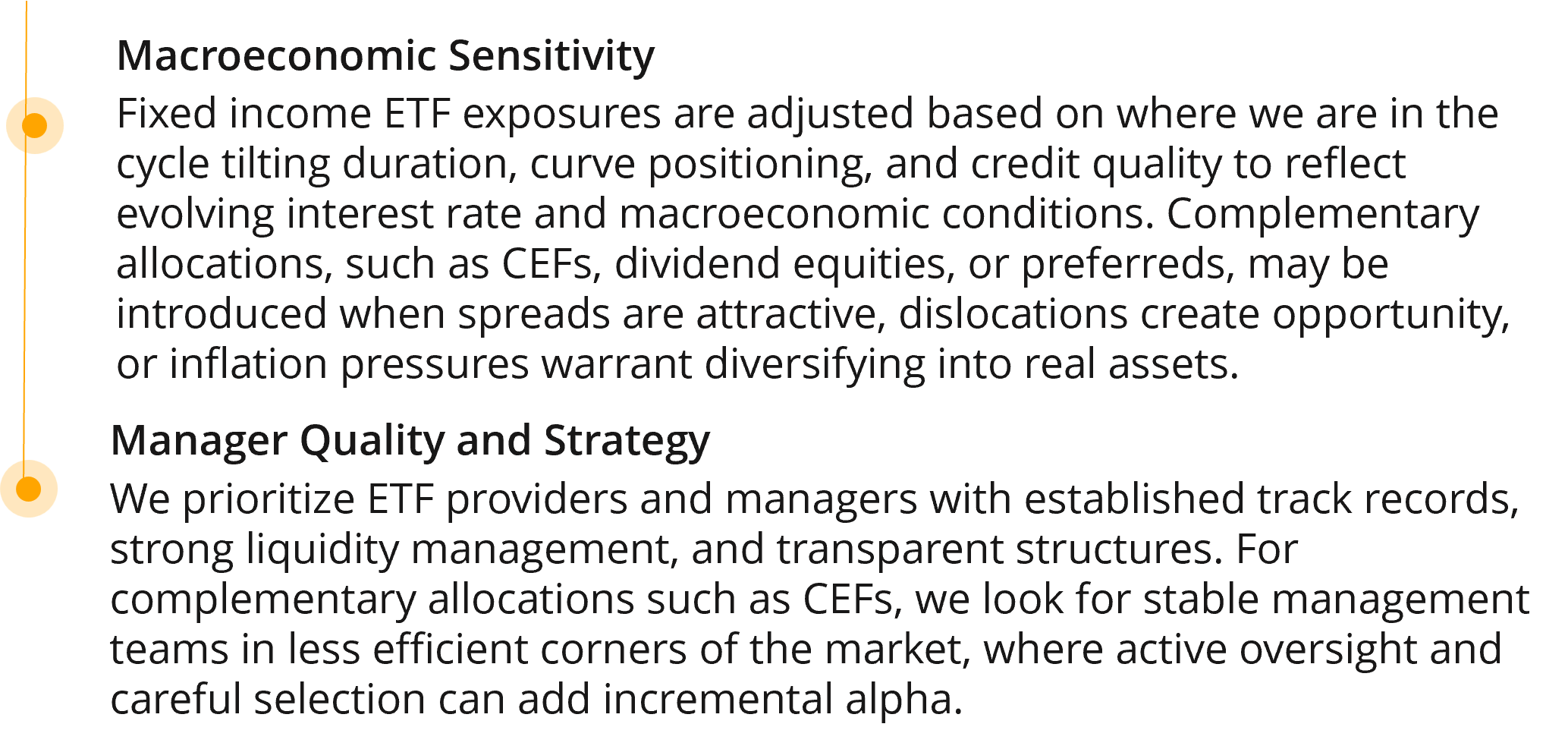Investor Education
Learn how THRV seeks to generate consistent income, why we pair an ETF core with targeted income sleeves, and how the “Always On” protection layer works.
Why Choose ETF’s?
ETF’s (Exchange-traded funds) have seen increasing popularity among advisors & investors.
Why we have ETFs incorporated into our Strategy:
Targeted Exposure
Lower Costs
Tax Efficiency through in kind transfers
Portfolio Transparency
Liquidity & Trading Flexibility
Diversification & Improved Risk Management
ETF vs. Mutual Funds - Inflow/Outflow
How THRV Approaches Income
The Prospera Income ETF (THRV) is a flexible, “go anywhere” actively managed income strategy focused on delivering consistent monthly income. THRV is designed to deliver consistent monthly income by anchoring its portfolio in a core allocation of high-quality fixed income ETFs. These positions provide structural stability, daily liquidity, and efficient access to segments of the bond market across the yield curve. Around this foundation, the fund tactically allocates to closed-end funds (CEFs), dividend-paying equities, preferred shares, real assets, and commodities each carefully selected to enhance yield, diversify risk, and add resilience against inflationary pressures.
To help cushion the impact of market downturns, the strategy maintains an “Always On” protection layer with 0.25% of the portfolio in protective puts. This hedge is scalable up to 10% in periods of heightened volatility to buffer drawdowns and preserve capital.
Our Core: Fixed Income ETFs
The foundation of the portfolio is a diversified allocation (40–60%) to fixed income ETFs. These vehicles provide transparent, liquid, and cost-efficient exposure across the bond market, allowing the investment team to actively manage duration, credit quality, sector mix, and curve positioning. By using ETFs as the core, the strategy benefits from both structural stability and tactical flexibility, ensuring the portfolio can adapt to evolving macro and interest rate environments.
Building Around The Core
The Role of Complementary Allocations
We construct the remainder of the portfolio with a tactical mix of income-oriented assets that complement our ETF core. These include CEFs, dividend-paying equities, preferred securities, commodities, and real estate assets. These allocations are intended to:
-
Our rotating core complements are tactical, designed to expand yield potential and portfolio resilience
-
Balancing factors across yield generating assets with total portfolio risk delivers multiple uncorrelated income streams, enhancing durability of monthly distributions.
-
We systematically adjust our exposure and preferred positions based on current macro and market conditions across all asset classes and sectors
Tactical Yield Enhancement
Beyond the Core: How We Think About Each Sleeve
-
We believe these vehicles offer some of the most attractive income streams available in public markets but require deeper diligence and a more nuanced understanding of structure and risk.
-
We selectively add individual equity positions with:
• Strong dividend yields (relative to sector or index)
• Healthy balance sheets (low debt, free cash flow support)
• Sensible valuation (not chasing growth or speculative multiple expansion)
-
We use preferred securities to capture attractive yields that sit between traditional bonds and common equity in the capital structure. Preferreds often provide higher income than investment-grade bonds while offering greater stability than common stock dividends
-
This exposure is calibrated carefully designed to enhance yield and diversification without adding excessive FX or political risk. It’s particularly useful in environments where U.S. dollar strength begins to fade or when global equity markets offer better value than domestic names.
-
Commodities, particularly via income-generating structures like royalty trusts or certain commodity-linked equity funds, play a selective but important role.
How We Think About Protection
-
We carry a small, continuous layer of protective puts (~0.25% budget) as baseline insurance. It’s more efficient than buying protection during a downturn and periods of high volatility. Our opening budget targets ~15-20% of notional equity exposure across the entire portfolio
-
We purchase put options on the S&P500 for equity exposure. For interest rate and credit risk we buy puts on single ETFs that carry sensitivity to rates or credit, subject to available market depth (open interest) and positioning.
-
We may increase hedge size as risk-regime probabilities migrate toward “risk-off,” the vol term structure dislocates, or realized vs. implied volatility gaps widen, subject to cost and impact
-
Hedges can reduce drawdown depth and speed, but they won’t eliminate loss and can trim upside during sharp rebounds
-
We target a budgeted carry for baseline protection and use position and tenor limits when scaling to manage cost, liquidity, and gap risk
Options involve risk and may not be suitable for all investors, hedging may also reduce upside and be costly.
ETF Mechanics (Creation Redemption)
Strategic Efficiency Through ETFs
-
You trade THRV on the exchange; authorized participants (APs) handle creations/redemptions in large “creation units”
-
Where feasible, in-kind baskets can reduce realized gains within the portfolio
-
Active ETFs like THRV may use custom baskets to manage exposures and push out low-basis or short-term positions, supporting tax efficiency over time
-
Daily holdings and the ETF structure allow us to adjust sleeves while maintaining liquidity.
Why We Use Closed End Funds
Understanding Closed End Funds (and why we are selective)
A tactical tilt of the portfolio is a concentrated allocation (20–30%) to Closed-End Funds (CEFs). We believe these vehicles offer some of the most attractive income streams available in public markets but require deeper diligence and a more nuanced understanding of structure and risk.
We evaluate CEFs across several dimensions before they’re included in the portfolio:
-
We look for funds trading at a persistent or widening discount to NAV, ideally with mean-reversion potential. We also consider funds that historically trade at a premium, when that premium is justified by yield stability or distribution quality, or is trading below it’s historical premium
-
High yielding assets can be risky. We assess not just current yield, but coverage ratios, earnings power, and whether distributions are sourced from income, return of capital or special corporate actions. We focus on investments that are a source of quality distributions that can be sustained based on their underlying assets, and not their leverage
-
We evaluate the structure and use of leverage, especially in a rising rate environment. Funds using high-cost borrowings or overly aggressive leverage are flagged
-
Both market liquidity (daily volume) and portfolio liquidity are reviewed. We avoid thinly traded CEFs that could become difficult to exit during volatility
-
We examine the CEF's holdings at the portfolio level, sector concentration, credit quality, geographic mix, and embedded duration or spread risk
Key Features of Closed End Funds
-
Shares are not created or redeemed daily; they trade on exchanges
-
CEFs often trade at prices above or below their Net Asset Value (NAV)
-
Many CEFs borrow capital to increase income potential, amplifying both returns and risks
-
Often pay high, regular income, typically monthly or quarterly
-
Shares can be bought or sold anytime during market hours, however some Closed End Funds have low liquidity increasing the risk
-
Portfolio managers actively select holdings and manage risk
Distributions and Taxes
Monthly Distributions and What They Mean
THRV seeks to pay monthly. The amount can vary and isn’t guaranteed. Distributions may include ordinary income, qualified dividends, capital gains, and/or return of capital (ROC). Your Form 1099-DIV will break this out each year.
Consult a tax professional; individual situations vary
Key Risks to Consider
Market & Equity Risk: Prices can decline; hedges may not offset losses.
Interest-Rate & Credit Risk: Bond prices fall as rates rise; credit spreads can widen.
CEF-Specific Risks: Leverage, discount volatility, manager risk, and potential liquidity constraints.
Derivatives Risk: Options can lose value; hedging may reduce upside or be unavailable at desired costs.
Allocation Risk: Tactical sleeve sizing may help or hurt outcomes depending on conditions.
Operational/Trading: Bid/ask spreads, premiums/discounts, and market stress can impact execution.
Please see prospectus for full risk disclosures
-
A small, continuous baseline of protective puts that may scale tactically when risk builds, through a small allocation to risk budget we try and insulate ~15-20% of the total portfolio from systematic equity risk, which can scale during periods of heightened stress
-
No. The Fund seeks to pay monthly distributions, but amounts vary and are not guaranteed; distributions may include ROC
-
Selective CEF exposure can add specialized income and discount opportunities, balanced by strict risk and liquidity controls
-
To the extent that we can be, the fund will use In-Kind transfers to lower the impact of realized gains, however income and distributions will be subject to your individual tax situation and type of distributions received
-
When our regime model shifts toward risk-off or volatility/term-structure signals indicate rising left-tail risk, subject to predefined cost and exposure limits
FAQ
Downloads and Contact Information
THRV: Investor Guide
Fact Sheet
Prospectus
Presentation
Please Contact IR@prosperafunds.com for any questions you may have regarding the fund or strategy
Disclosures
SAI
Meet Your Wholesaler
There is no guarantee that the Fund will achieve its investment objective. An investment in the Fund involves a high degree of risk, including the potential loss of the entire investment. The Fund is subject to the risks of its underlying funds in addition to general economic and market conditions. The Fund and its service providers are subject to operational and cybersecurity risks. Past performance does not guarantee future results.
The options overlay strategy is implemented using a proprietary rules-based model developed by the Fund's adviser. This model evaluates market volatility regimes, macroeconomic indicators, and technical risk signals to calibrate hedging exposures dynamically. There is no guarantee that the hedge will be successful or that it will reduce losses during future market downturns. Derivative instruments, including index puts and VIX call options, involve additional risks and may increase portfolio volatility. Past performance does not guarantee future results.
ETFs are subject to market risk, including the loss of principal. Diversification does not guarantee protection against loss.
Before investing, carefully consider the Fund’s investment objectives, risks, charges, and expenses. This and other important information is contained in the Fund’s Prospectus. Please read the prospectus carefully before investing.
Securities offered through Vigilant Distributors, LLC, member of FINRA/ SIPC.
This advertisement does not constitute an offer to sell, nor a solicitation of an offer to buy the securities described herein.
NOT FDIC INSURED | NO BANK GUARANTEE | MAY LOSE VALUE ON BOTH.




